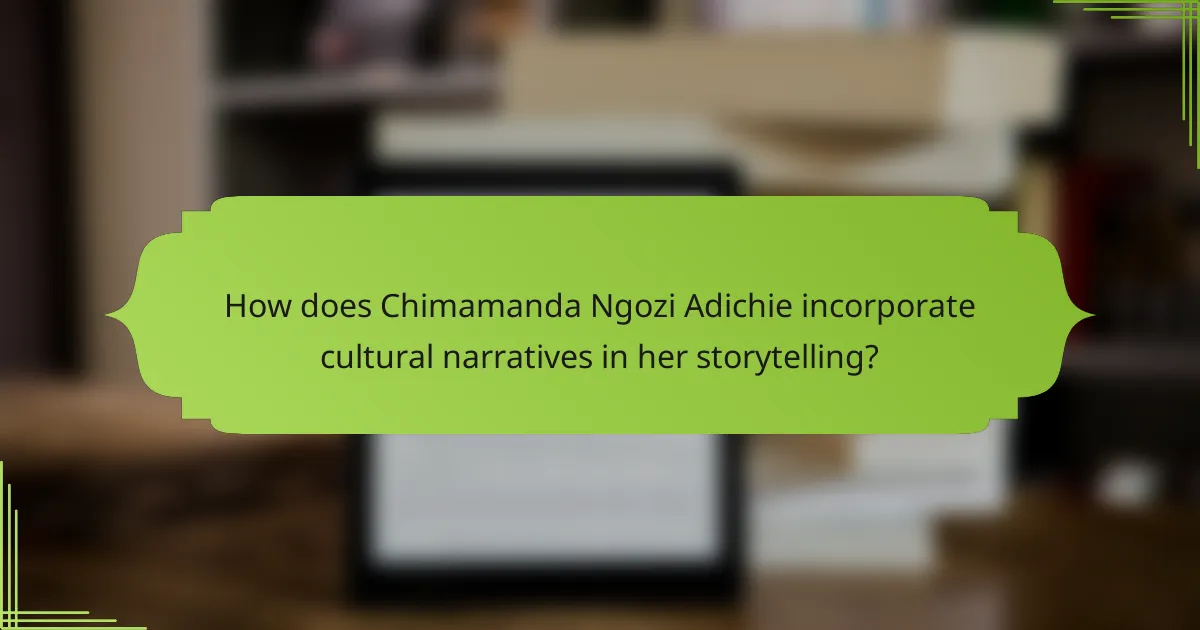Chimamanda Ngozi Adichie is a pivotal figure in contemporary literature, known for her exploration of feminist themes and cultural narratives. Her works examine gender equality and the critique of patriarchal structures while showcasing the resilience of women in Nigerian society. Adichie’s unique narrative style blends personal experiences with broader social commentary, highlighting the intersectionality of race, gender, and class. Through her influential essays and novels, she fosters essential discussions on identity and representation in global feminist discourse.

What feminist themes are prevalent in Chimamanda Ngozi Adichie’s works?
Chimamanda Ngozi Adichie’s works prominently feature feminist themes such as gender equality, female empowerment, and the critique of patriarchal structures. Her narratives often explore the intersection of culture and gender, highlighting the unique experiences of women in Nigerian society.
Adichie’s characters frequently challenge traditional gender roles, showcasing resilience and independence. In “Half of a Yellow Sun,” she illustrates the impact of war on women, emphasizing their strength in adversity. Similarly, “We Should All Be Feminists” articulates the necessity of feminism in contemporary society, advocating for equal rights.
Her literary contributions foster discussions on identity and cultural expectations, making her a vital voice in modern feminist literature. Adichie’s unique perspective enriches the dialogue surrounding women’s rights, encouraging readers to reflect on societal norms.
How do Adichie’s narratives challenge traditional gender roles?
Adichie’s narratives challenge traditional gender roles by presenting strong female characters who defy societal expectations. Her works, such as “Half of a Yellow Sun” and “Purple Hibiscus,” highlight women’s resilience and agency. Adichie addresses issues like domestic violence and gender inequality, prompting readers to reconsider entrenched stereotypes. By integrating personal experiences and cultural context, she advocates for a nuanced understanding of femininity and masculinity, ultimately reshaping perceptions of gender roles in contemporary society.
Which characters embody feminist principles in her novels?
Chimamanda Ngozi Adichie’s characters often embody feminist principles through their resilience and independence. Notable examples include Ifemelu from “Americanah,” who navigates identity and race while asserting her agency, and Kambili from “Purple Hibiscus,” who seeks freedom from oppressive familial structures. These characters challenge societal norms and advocate for personal empowerment, reflecting Adichie’s commitment to feminist themes. Additionally, characters like Olanna in “Half of a Yellow Sun” demonstrate the complexities of womanhood in the context of war, further illustrating the intersection of gender and cultural narratives.

How does Chimamanda Ngozi Adichie incorporate cultural narratives in her storytelling?
Chimamanda Ngozi Adichie skillfully weaves cultural narratives into her storytelling to highlight identity and social issues. Her works often reflect the complexities of Nigerian culture, emphasizing themes of feminism and post-colonialism. For example, in “Half of a Yellow Sun,” she explores the impact of the Nigerian Civil War on personal lives, showcasing unique cultural perspectives. Adichie’s incorporation of folklore and traditional storytelling methods enriches her narratives, making them resonate with diverse audiences. This blend of cultural elements and personal experiences solidifies her contributions to contemporary literature.
What role does Nigerian culture play in her literary works?
Nigerian culture profoundly influences Chimamanda Ngozi Adichie’s literary works. Her narratives weave traditional customs, societal norms, and historical contexts into feminist themes, creating rich cultural tapestries. Adichie’s characters often face the complexities of identity shaped by Nigerian heritage, reflecting both personal and collective struggles. For instance, she explores the intersections of gender and culture, highlighting how cultural expectations impact women’s lives. This cultural grounding enhances her storytelling, making it relatable and impactful for diverse audiences.
How does Adichie address post-colonial themes through her characters?
Adichie addresses post-colonial themes through her characters by exploring identity, cultural conflict, and the impact of colonial history. Her characters often navigate the complexities of their heritage, reflecting the struggle between traditional values and modern influences. For example, Ifemelu in “Americanah” grapples with her Nigerian identity while living in the United States, highlighting the nuances of race and belonging. Adichie’s portrayal of characters reveals the ongoing effects of colonialism on personal and collective identities, emphasizing resilience and the search for self-definition.

What are the key literary contributions of Chimamanda Ngozi Adichie?
Chimamanda Ngozi Adichie significantly contributes to literature through her exploration of feminist themes, cultural narratives, and identity. Her works, such as “Half of a Yellow Sun” and “We Should All Be Feminists,” challenge societal norms and highlight the complexities of gender and culture. Adichie’s unique narrative style blends personal experience with broader social commentary, making her a prominent voice in contemporary literature. Her ability to articulate the struggles and triumphs of women in diverse contexts resonates globally, fostering dialogue on equality and representation.
Which awards and recognitions has she received for her writing?
Chimamanda Ngozi Adichie has received numerous awards for her writing, including the Orange Prize for Fiction in 2004 and the National Book Critics Circle Award in 2013. She is recognized for her contributions to literature, particularly in feminist themes and cultural narratives. Her work has earned her the MacArthur Fellowship in 2008, highlighting her unique literary voice and impact. Additionally, she was awarded the PEN Pinter Prize in 2018, further solidifying her status in contemporary literature.
How has Adichie’s work influenced contemporary literature?
Chimamanda Ngozi Adichie’s work has profoundly influenced contemporary literature by highlighting feminist themes and diverse cultural narratives. Her novels, such as “Half of a Yellow Sun” and “Americanah,” explore identity, race, and gender, challenging traditional storytelling norms. Adichie’s emphasis on the complexity of women’s experiences has inspired a new generation of writers to address similar issues. Her TED Talk, “We Should All Be Feminists,” has further popularized feminist discourse, making her a pivotal figure in modern literary discussions. Through her unique voice, Adichie has reshaped the landscape of contemporary literature, encouraging inclusivity and representation.

In what ways does Adichie’s writing reflect intersectionality?
Adichie’s writing reflects intersectionality through its exploration of multiple identities and social categories. Her characters navigate race, gender, and class, revealing how these intersecting factors impact their experiences. For instance, in “Americanah,” the protagonist’s journey highlights the complexities of being a black woman in both Nigeria and America, emphasizing cultural narratives that resonate with diverse audiences. Additionally, her essays, like “We Should All Be Feminists,” advocate for a broader understanding of feminism that includes various social identities, illustrating how systemic inequalities are interconnected.
How does she portray the experiences of women from diverse backgrounds?
Chimamanda Ngozi Adichie portrays the experiences of women from diverse backgrounds by highlighting their unique struggles and strengths. She emphasizes intersectionality, showcasing how factors like race, class, and culture shape women’s identities. Adichie’s narratives often include characters who navigate societal expectations, personal aspirations, and cultural heritage. This multifaceted approach allows her to resonate with a wide audience, reflecting the complexities of women’s lives globally. Through her works, she advocates for empowerment and understanding, making her contributions vital to contemporary feminist discourse.
What unique perspectives does Adichie offer on race and gender?
Chimamanda Ngozi Adichie offers unique perspectives on race and gender through her exploration of intersectionality. She emphasizes how societal constructs shape individual experiences, particularly for women of color. Adichie’s narratives often highlight the complexities of identity, illustrating how race and gender intersect to influence personal and collective stories. Her works challenge stereotypes and advocate for a more nuanced understanding of feminism that includes diverse voices and experiences.

How has Chimamanda Ngozi Adichie impacted global feminist discourse?
Chimamanda Ngozi Adichie has profoundly influenced global feminist discourse through her literary works and public speeches. Her book “We Should All Be Feminists” redefined feminism, making it accessible and relatable. Adichie’s unique perspective combines personal narratives with cultural critiques, emphasizing intersectionality. Her advocacy for women’s rights resonates worldwide, inspiring movements and discussions on gender equality.
What are the implications of her TED Talks and public speeches?
Chimamanda Ngozi Adichie’s TED Talks and public speeches significantly influence feminist discourse and cultural narratives. Her emphasis on personal experiences fosters empathy and challenges stereotypes. Adichie’s unique storytelling style engages diverse audiences, promoting conversations about gender equality. As a result, her work inspires action and advocacy for women’s rights globally.
How do her writings resonate with audiences in different cultural contexts?
Chimamanda Ngozi Adichie’s writings resonate across cultures by addressing universal themes of identity, gender, and social justice. Her narratives reflect diverse cultural experiences, making her work relatable to various audiences. For instance, her exploration of feminism transcends geographical boundaries, allowing readers to connect with her perspectives on women’s rights and empowerment. Adichie’s unique ability to weave personal stories with broader societal issues fosters empathy and understanding among different cultural contexts. As a result, her literary contributions continue to inspire and provoke thought globally.

What are some common misinterpretations of Adichie’s works?
Common misinterpretations of Chimamanda Ngozi Adichie’s works include oversimplifying her feminist messages, misunderstanding cultural contexts, and overlooking the complexity of her characters. Many readers mistakenly view her narratives as solely focused on gender issues, neglecting the rich cultural and social layers present in her storytelling. Additionally, some interpretations fail to recognize the intersectionality in her works, which addresses various identities and experiences beyond feminism alone. These misinterpretations can lead to a limited appreciation of her literary contributions and the nuanced narratives she presents.
How can readers better understand her themes and messages?
Readers can better understand Chimamanda Ngozi Adichie’s themes and messages by engaging with her diverse body of work. Analyzing her narratives reveals insights into feminist themes, cultural identity, and the complexities of gender dynamics. Her storytelling often intertwines personal experiences with broader societal issues, making her messages relatable and impactful. Additionally, exploring interviews and essays provides context on her perspectives, enhancing comprehension of her literary contributions.
What misconceptions exist about her portrayal of feminism?
Chimamanda Ngozi Adichie’s portrayal of feminism often faces misconceptions, primarily around her views being perceived as exclusionary. Critics sometimes misinterpret her emphasis on the experiences of women of color as a dismissal of other feminist perspectives. Additionally, some believe her advocacy for gender equality overlooks intersectionality, which is not the case. Adichie’s work highlights diverse narratives, showcasing that feminism can be inclusive and multifaceted. Her essays and speeches encourage dialogue about cultural narratives, challenging the notion that feminism is a monolithic concept.
What practical tips can readers apply to engage with her literature effectively?
To engage effectively with Chimamanda Ngozi Adichie’s literature, readers should immerse themselves in her cultural narratives and feminist themes. Start by exploring her diverse characters and their experiences, which reflect broader societal issues. Analyze the intersectionality present in her works, considering how race, gender, and culture shape her narratives. Engage with her storytelling style, noting her use of language and imagery to convey emotions and themes. Join discussions or book clubs focused on her literature to deepen understanding and share perspectives. Lastly, reflect on the relevance of her themes in contemporary society, fostering personal connections to her messages.